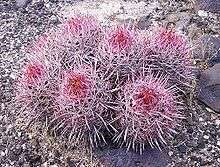Echinocactus polycephalus
| Echinocactus polycephalus | |
|---|---|
 | |
| Echinocactus polycephalus | |
| Scientific classification | |
| Kingdom: | Plantae |
| (unranked): | Angiosperms |
| (unranked): | Eudicots |
| (unranked): | Core eudicots |
| Order: | Caryophyllales |
| Family: | Cactaceae |
| Subfamily: | Cactaceae |
| Tribe: | Cacteae |
| Genus: | Echinocactus |
| Species: | E. polycephalus |
| Binomial name | |
| Echinocactus polycephalus Engelm. & J.M. Bigelow | |
Echinocactus polycephalus is a cactus that occurs in the Mojave Desert region of Arizona, California, and Nevada. It also occurs in the Sonoran Desert region of southern California and northern Sonora, Mexico.
The plants grow in some of the most extreme arid environments in the American Southwest, such as Death Valley National Park, and the Mojave National Preserve of Southern California.
Description
The stems of Echinocactus polycephalus are sometimes solitary, but more often in clusters of as many as 30, each up to 0.6 m tall. The spines are yellow to red. The fruits are densely woolly, giving the common name "Cotton top cactus".[1] In the past, it was also called "niggerhead cactus."[2][3]
They have a reputation for being difficult in cultivation, and are rarely seen in cactus collections.
References
External links
| Wikimedia Commons has media related to Echinocactus polycephalus. |
